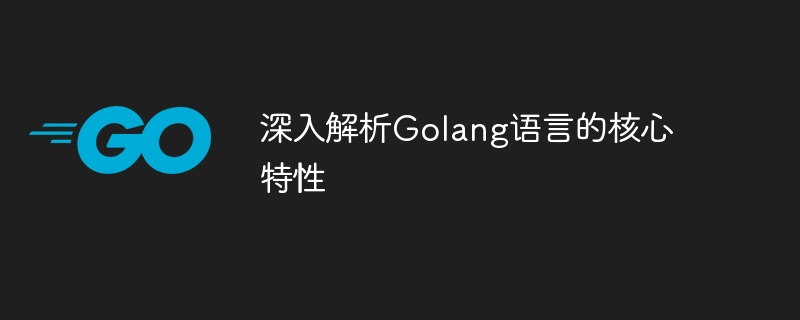Home >Backend Development >Golang >In-depth analysis of the core features of Golang language
In-depth analysis of the core features of Golang language
- PHPzOriginal
- 2024-02-28 14:45:03759browse

Golang (also known as Go) is an open source programming language developed by Google. It is designed to handle large-scale projects and focuses on simplicity, efficiency, and ease of writing. This article will deeply analyze the core features of the Golang language, including concurrent programming, garbage collection, type system, etc., and explain it in detail with specific code examples.
Concurrent programming
Golang considered the needs of concurrent programming from the beginning of its design, and implemented lightweight concurrency processing through goroutine and channel. Goroutine is a lightweight thread that can create thousands of goroutines in Golang programs to execute tasks concurrently. The channel is a pipeline used for communication between goroutines, which can safely transfer data.
The following is a simple concurrency example that uses goroutine to calculate the Fibonacci sequence:
package main
import "fmt"
func fibonacci(n int, ch chan int) {
x, y := 0, 1
for i := 0; i < n; i++ {
ch <- x
x, y = y, x+y
}
close(ch)
}
func main() {
ch := make(chan int)
go fibonacci(10, ch)
for num := range ch {
fmt.Println(num)
}
}In the above example, we use goroutine to calculate the first 10 terms of the Fibonacci sequence , and transmit the results through the channel. The main program reads the data in the channel through a for loop and outputs it.
Garbage Collection
Golang uses a concurrent mark-sweep based garbage collector to manage memory. The garbage collector regularly checks for useless memory objects in the program and reclaims the space occupied by these objects, thereby reducing the risk of memory leaks.
The following is a simple garbage collection example that triggers garbage collection by creating a large number of objects and releasing the memory manually:
package main
import (
"fmt"
"runtime"
)
type Person struct {
Name string
}
func createObjects() {
for i := 0; i < 1000000; i++ {
_ = &Person{Name: fmt.Sprintf("Person%d", i)}
}
}
func main() {
createObjects()
runtime.GC()
var stats runtime.MemStats
runtime.ReadMemStats(&stats)
fmt.Printf("Allocated memory: %d bytes
", stats.Alloc)
}In the above example, we created 1 million Person objects and Manually call runtime.GC() after creation to trigger garbage collection. Finally, we use the runtime.MemStats structure to obtain the memory size allocated by the program.
Type system
Golang’s type system is statically typed and supports interface types. An interface type is an abstract type that does not contain any specific implementation and can be used to achieve polymorphism.
The following is a simple interface example, defining an interface Animal and two structures Cat and Dog, respectively implementing the Animal interface:
package main
import "fmt"
type Animal interface {
Speak()
}
type Cat struct {}
func (c Cat) Speak() {
fmt.Println("Meow!")
}
type Dog struct {}
func (d Dog) Speak() {
fmt.Println("Woof!")
}
func main() {
animals := []Animal{Cat{}, Dog{}}
for _, animal := range animals {
animal.Speak()
}
}In the above example, we defined an interface Animal, contains a Speak method. Then we defined the Cat and Dog structures respectively and implemented the Speak method. Finally, we create an Animal slice containing Cat and Dog objects and call the Speak method to achieve polymorphism.
Through the above examples, we have deeply analyzed the core features of the Golang language, including concurrent programming, garbage collection, and type systems, and explained them in detail with specific code examples. As a concise and efficient programming language, Golang has obvious advantages when handling large-scale projects, providing developers with powerful tools and features.
The above is the detailed content of In-depth analysis of the core features of Golang language. For more information, please follow other related articles on the PHP Chinese website!
Related articles
See more- How to use the garbage collector
- A detailed introduction to the Java virtual machine: JVM garbage collector
- Explore memory optimization technology and garbage collector management in Go language
- Implement efficient memory management and garbage collector tuning in Go language
- Developed using Go language, how to reasonably manage memory and garbage collector

